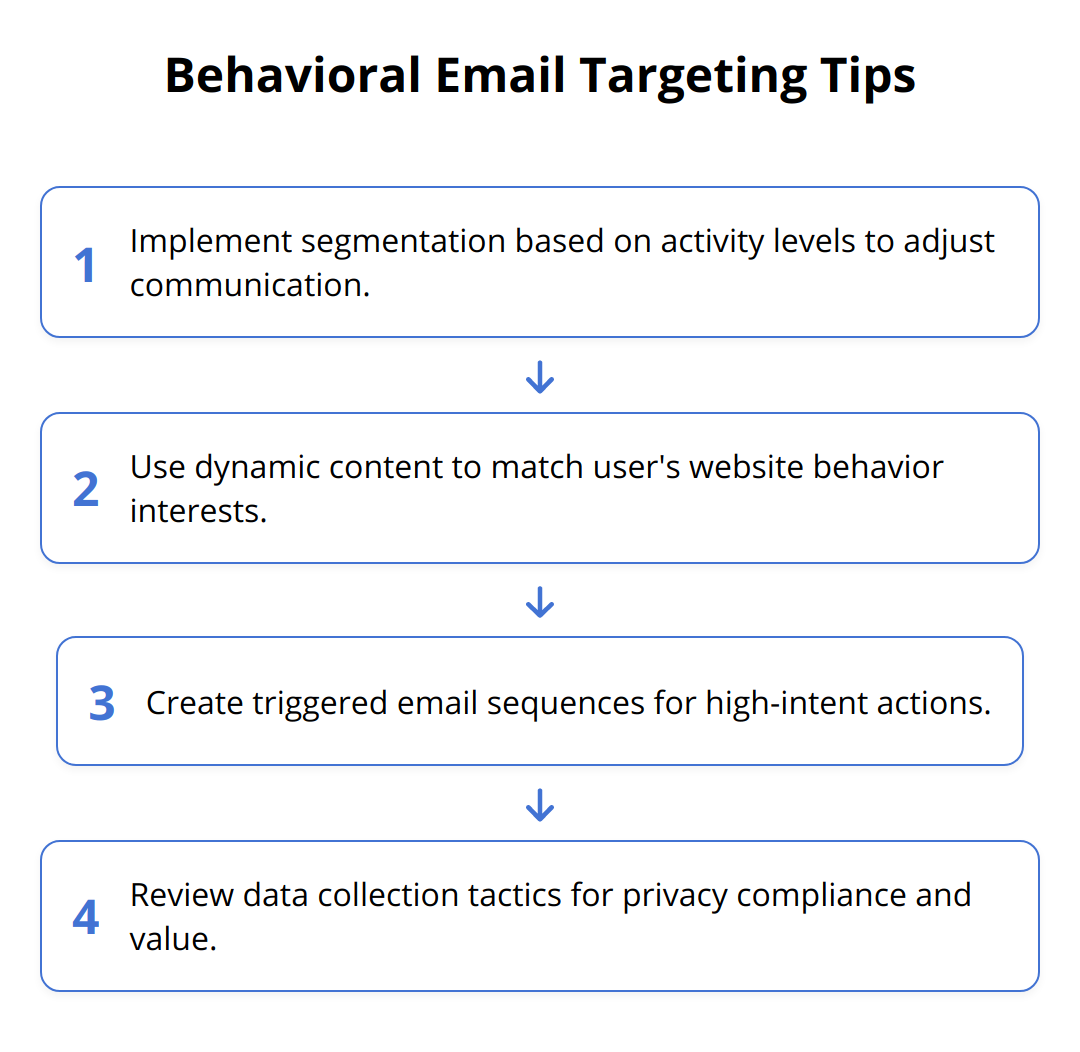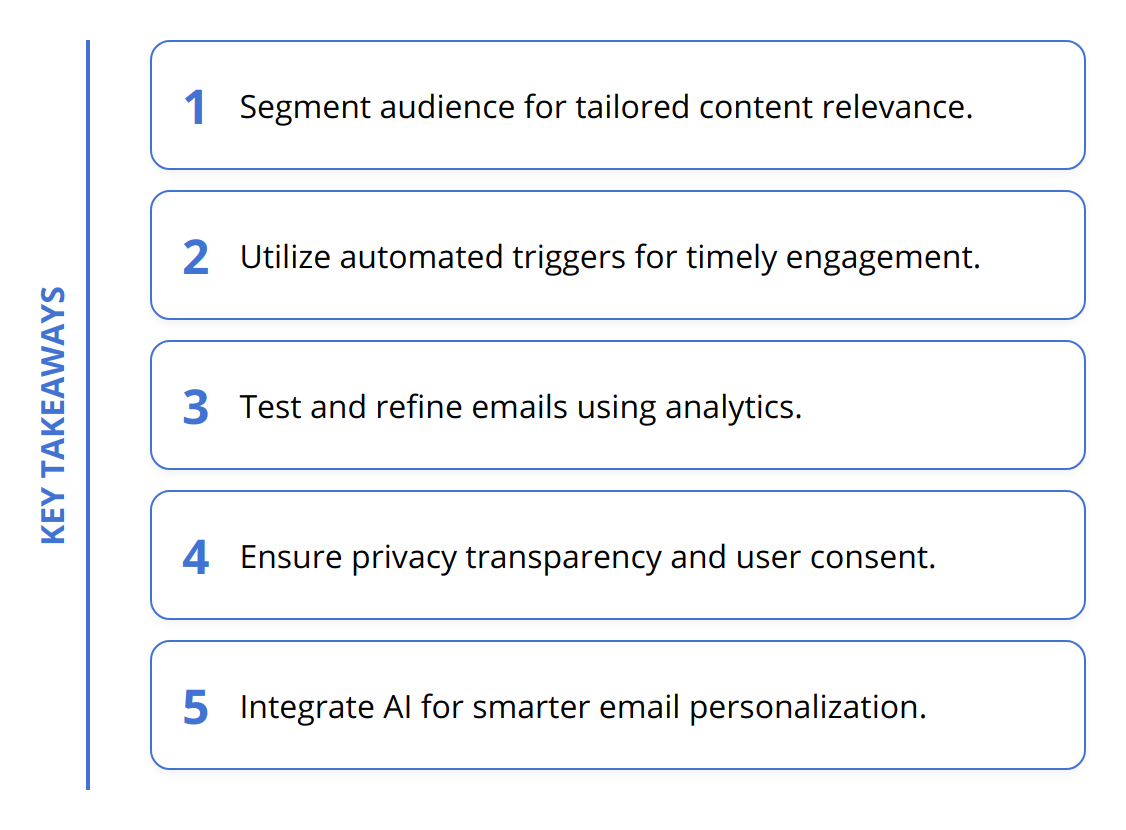We at Emplibot believe that mastering the art of behavioral email targeting is key to connecting with your audience in a meaningful way. Personalized marketing is not just a buzzword; it’s a proven strategy to increase engagement and boost your business’s bottom line. By leveraging user data effectively, you can transform your email campaigns into highly targeted messages that resonate with each recipient. Let’s explore the world of behavioral email marketing, from the essentials of data collection to the intricacies of crafting personalized content.
Harnessing Behavioral Data in Email Campaigns
Email marketing is not just about sending out newsletters and hoping for the best. It’s about understanding and acting on the behaviors of your subscribers. Behavioral email targeting is the strategic powerhouse behind effective email campaigns. It goes beyond basic demographics and taps into the unique actions and desires of each user. Think of it as marketing empathy—putting yourself in the digital footsteps of your audience to deliver emails that hit home.
Why prioritize personalized marketing? Because data doesn’t lie. Personalized emails deliver six times higher transaction rates, but 70% of brands fail to use them. Clearly, there’s a vast opportunity for those who get it right to leapfrog ahead of competition. And with every click, page view, and purchase, your customers are giving you the hints you need to tailor your content.

So, what types of behavioral data should you be looking at? Your gold mine includes:
-
Email Engagement: Measure it by tracking opens, clicks, and interaction times. Are your users quick to open your emails, or do they languish unloved in inboxes?
-
Website Interaction: It’s not just about visits; it’s which pages keep your users interested and for how long. This data helps adjust campaign focus to match user interests.
-
Purchase Behavior: Your best clues come from what customers buy and when. Repeat purchases spell brand loyalty, while abandoned carts call for a nudge back to the checkout.
Combining these insights lets you craft email masterpieces. Remind your customers of what they left behind with an abandoned cart automation or celebrate their purchase anniversary with a personalized offer to boost retention rates.
Practical tips for using behavioral email targeting:

Remember to keep a finger on the pulse of your customers’ changing behaviors. Successful marketers continuously refine their strategies and evolve with the trends. This isn’t a one-time set up; it’s a commitment to perpetual improvement.
So, take a good look at how users are interacting with your brand across all touchpoints. Your next email campaign could be a conversion powerhouse, with a little help from behavioral targeting.
Why Behavioral Email Wins
Tailoring your email marketing to the behaviors of your audience is not just smart; it’s downright effective. Imagine sending a wave of emails and watching as your engagement metrics soar and your ROI shoots up. That’s the power of behavioral email marketing, and here’s why it stands out:
Higher Engagement and Conversion Rates
When emails resonate with recipients, they are more likely to open, click, and convert. Behavioral email marketing isn’t a shot in the dark. It’s based on actual data that tells you what your users are interested in, and what they’re likely to buy. For instance, did you know that emails triggered by behavior have an over 152% higher open rate compared to traditional emails? And not only do they get opened, but they also yield better conversions. The personal touch added to behavioral emails makes them more than twice as likely to convert.

Improved Customer Experience and Satisfaction
Customers love feeling understood. By analyzing behavior and customizing communication, you’re showing that you pay attention to their needs and preferences. A personalized experience not only enhances customer satisfaction but also fosters loyalty. In a crowded marketplace, giving your customers what they want before they ask for it separates you from the pack. Businesses that excel in this area are the ones that customers remember and return to.

Efficient ROI and Lower Bounce Rates
Investing in behavioral email marketing yields returns that are well worth the effort. By targeting users who are already engaged with your brand, you spend less to earn more—a marketer’s dream scenario. Behavioral emails also tend to have lower bounce rates because they’re relevant. The content aligns with the recipient’s interests, reducing the likelihood they’ll hit that dreaded ‘unsubscribe’ button. By cutting through the noise with pointed, behavior-driven content, you’re not just reaching more people; you’re reaching the right people.
Here are some actionable takeaways to help you capitalize on behavioral email marketing:
-
Integrate robust analytics to continuously gather deep insights on user interactions.
-
Tailor your automations, like email retargeting, to ensure you’re striking while the iron is hot.
-
Keep user data pristine with regular cleaning and updates, which helps maintain a high level of personalization.
Capitalize on behavioral email marketing, and you’ll notice the tangible benefits of building stronger connections with your audience. It’s not just about selling; it’s about nurturing a relationship with each click and conversion.
How to Craft Targeted Behavioral Emails
Shifting from a one-size-fits-all email strategy to one that is behaviorally targeted can significantly improve your engagement and conversion rates. By carefully crafting trigger-based email automations, personalizing content, and timing your emails with precision, you can create a marketing campaign that speaks directly to your user’s interests and habits.
Crafting Trigger-Based Email Automations
Automation is your friend. However, not just any automation—the key is to design campaigns triggered by specific user actions. This strategy breathes life into your customer interactions, making your emails relevant and timely. For example, if a customer has browsed a particular category but left without making a purchase, setup an automated email that showcases items from that category, perhaps with a limited-time offer. Suddenly, you’re not just sending an email; you’re extending a personalized invitation to revisit their interest.
Here are a few concrete steps to take:
-
Map out user behaviors that indicate high purchase intent, such as viewing product pages multiple times.
-
Develop email sequences that respond to these behaviors, like sending a detailed product guide after a user downloads a related resource.
-
Always keep testing your triggers—what works today might not work tomorrow.
Personalizing Content Based on User Activity
Mass emails are passé. Today, it’s all about hyper-personalization. Use the goldmine of user activity data to tailor your message down to the individual level. Are particular users always clicking on tech gadgets? Seduce them with the latest smart-home devices. Do others linger on pages about health and wellness? Entice them with your new line of eco-friendly supplements.
Powerful personalization involves:
-
Dynamic email content that adjusts based on the user’s most frequent interactions.
-
Progressive profiling to further refine your understanding and targeting of the user’s preferences.
-
Checking out customer nurturing strategies for in-depth methods to keep your user engaged.

Timing Emails to Coincide with User Behavior
In email marketing, timing can be the difference between a sale and a missed opportunity. It’s essential to align your email dispatches with periods your users are most active and thus likely to engage. Late night browser? Schedule that promotional email for the wee hours. Early morning shopper? Hit them with your flash sale as they sip their morning coffee.
To get timing right:
-
Analyze peak activity times across different customer segments.
-
Set up email automations to deploy messaging that corresponds with these peak times.
-
Constantly refine your timing based on open and conversion rate analytics.
In conclusion, personalization, timing, and automation are not just trendy jargon; they’re tactical tools that can drive your email marketing success. Implement these strategies, and watch as your emails transform from ignored inbox fillers to impactful, action-inspiring messages. Keep your campaigns fluid, your data clean, and your strategy user-centered, and there’s no limit to the connections you can foster through sophisticated behavioral email targeting.
Best Practices for Behavioral Email Campaigns
In the competitive world of email marketing, adopting best practices isn’t just advisable; it’s absolutely necessary for campaign success. Here’s how to maximize the impact of your behavioral email campaigns with precision and finesse.
Respect and Permissions Are Non-Negotiable
We live in an age where privacy is paramount, and ignoring this is perilous for any marketer. Prioritize user privacy and make permission the foundation of your email campaigns. Each communication must be built on the explicit consent of your recipients. To gain trust and maintain compliance with regulations like GDPR, always:
-
Provide clear opt-in mechanisms for users to subscribe to your emails.
-
Ensure the option to unsubscribe is straightforward and available in every email.
-
Be transparent about what data you’re collecting and how it will be used.
Trust breeds loyalty, which in turn sparks better engagement and stronger relationships with your audience.
Master the Art of Segmentation
One of the most impactful strategies you can employ is razor-sharp segmentation. By slicing your email list into relevant segments, you dramatically increase the relevance of your communications. The aim is to send the right message to the right person at the right time, and segmentation makes this possible. Take advantage of tools and features such as those offered in marketing automation for better segmentation to:
-
Divide your larger email list into smaller, behavior-based segments.
-
Develop content that speaks directly to the unique needs of each segment.
-
Keep refining your segments based on interaction data and user feedback.
Segments aren’t static – continually assess and adjust them to mirror the evolving interests of your audience.
Consistently Test and Optimize
What’s the difference between good marketers and great ones? The latter never stop testing and optimizing. Behavioral email campaigns offer a gold mine of metrics that you can analyze to continually hone your strategy. But don’t rely on intuition—let the data guide your decisions. Adopt a culture of A/B testing with the following tactics:
-
Experiment with subject lines, email content, and sending times to see what yields the highest engagement.
-
Use split-testing for your calls to action to determine which get better results.
-
Regularly review your analytics to understand which parts of your email strategy are working and which aren’t.
Data-driven optimizations are the engines of breakthroughs in engagement and conversion rates.
In your quest to perfect your behavioral email campaigns, remember these best practices: prioritize privacy, perfect your segmentation, and pursue relentless testing and optimization. By embedding these principles into your strategy, you create a solid foundation that supports sophisticated, high-performing campaigns. With each email sent, you’re not just reaching an inbox; you’re engaging a person whose behaviors and preferences are guiding your messaging. And that, after all, is the essence of true behavioral email marketing mastery.
Wrapping Up
Behavioral email targeting has unfolded as a transformative tool in the email marketing arena. It’s the meticulous art of sending the right message at the right moment, extrapolating from the rich tapestry of user behaviors to craft highly personalized email experiences. The key lies in understanding and anticipating the needs of your audience, delivering impactful content that resonates and drives action.

Strategic implementation of behavioral email targeting can skyrocket engagement and conversion rates, bolstering customer satisfaction and loyalty along the way. The core takeaways we’ve laid out provide a blueprint for success:
-
Prioritize personalization by harnessing user behavior insights.
-
Segment your audience to ensure content relevance and engagement.
-
Employ timely and relevant automated email triggers.
-
Continuously refine strategies through robust testing and analytics.
At Emplibot, we recognize the outstanding potential of optimized email marketing to foster genuine connections between businesses and their customers. And in doing so, we advocate for the ethical use of data. Transparency, consent, and respect for privacy stand as the pillars of ethical personalization, guiding not just legal compliance but fostering trust and ensuring sustainability in strategies.
Looking ahead, anticipate email marketing to burgeon with smarter automation and more nuanced personalization techniques. Advances in technology amplify our capabilities to predict and respond to user actions with even greater precision. Preparing for these shifts means staying informed and adaptable, ready to integrate emerging practices that fortify your brand’s relevance.
Remember, the future of email marketing is dynamic and holistic, revolving around the user. Tailoring experiences and forging connections can set your campaigns apart in an increasingly crowded digital marketplace. Whether you’re a seasoned marketer or just starting, embracing behavioral email targeting can yield unprecedented success for your brand.
If you’re aiming to elevate your content creation alongside your email marketing strategies, we’re here to assist. Explore how Emplibot can help build your blog automatically, ensuring that your content strategy remains seamless and effective.
In summary, as we venture forward, the alliance of behavioral targeting and AI-driven content solutions like Emplibot marks a new dawn for email marketers—one where agility, foresight, and ethical data usage are not just beneficial but indispensable for sustained success.

